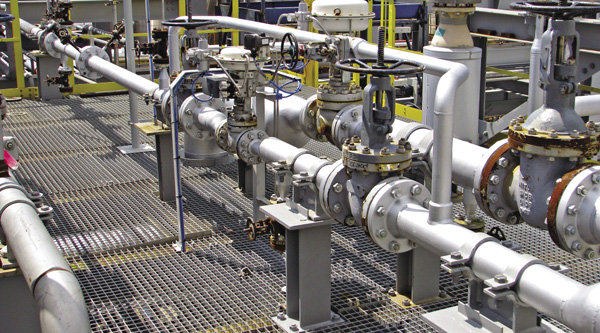The revised F-Gas Regulation will be applied from January 1, 2015 onwards. But what does it entail in practical terms? To answer this, eurammon has put together the most important facts and figures and background data on the regulation.
The revised F-Gas Regulation will be applied from January 1, 2015 onwards. But what does it entail in practical terms? To answer this, eurammon has put together the most important facts and figures and background data on the regulation.

The European Union’s climate and energy strategy with its so-called “20-20-20 targets” has resulted in a legislative package which aims, among others, to bring about a 20% reduction in greenhouse gas emissions by the year 2020. This is an ambitious undertaking that encompasses various specific measures. One of these refers to the use of partly fluorinated hydrocarbons or so-called F-gases. To minimise their impact on global warming, in April 2014 the EU Council adopted Regulation (EU) No 517/2014 on fluorinated greenhouse gases as the long-awaited revision of the F-Gas Regulation.
New regulations such as the ban on refrigerants that have a particularly strong impact on the climate should help the EU to achieve its climate targets and promote the use of technologies in the refrigeration and air conditioning branch, which significantly reduce the environmental impact. Europe is thus setting new global standards for reducing CO2 emissions. The revised F-Gas Regulation will be applied from January 1, 2015 onwards. But what does it mean in specific terms for manufacturers, system planners and operators? eurammon has put together the most important facts and background data.
Core elements of the revised F-Gas Regulation in detail
The targets of the revised F-Gas Regulation will be implemented with the following package of measures:
Phase-down – gradual reduction in the available quantity of F-gas
The EU will be gradually reducing the permitted total quantity of F-gases as from January 2015. The reference point (100%) consists of the mean available quantity of F-gases available on the market in the period 2009 to 2012. Working on this basis, the total quantity available in the EU will be reduced to 21% in six stages through to 2030. In order to take account of the differing climate impact of the various refrigerants, the quantity of F-gas is stated in tonnes of CO2 equivalents rather than an absolute value in kilogrammes. The CO2 equivalent is easily calculated with the following formula: quantity of refrigerant in kilogramme multiplied by the corresponding global warming potential (GWP)
Restrictions on use – prohibition of certain F-gases with high GWP
From 2020 onwards, stationary systems may no longer use refrigerants with a GWP > 2,500. This also applies to the maintenance of plants with a new refrigerant having more than 40 t CO2 equivalent – which corresponds approximately to about 10 kg filling of R404A and R507A. The only exemptions are systems in military use and systems that cool products to -50 degree C. Existing systems may still be operated through to 2030 and refilled, but only with processed or recycled F-gases. In a second stage, from 2022 refrigerants in multiple centralised refrigeration systems (at least two compressors, several cooling points and a refrigerating capacity of more than 40 kW) are permitted to have only a GWP < 150. Excluded from this is the primary refrigerant cycle in cascade systems in which F-gases may be used with a GWP
Quota system – allocated quotas for more control
In order to control refrigerant consumption, refrigerant manufacturers and importers will be allocated F-gas quotas on submitting a corresponding application. Quantities will be distributed according to the following key: altogether 89% of the total quantity will be shared out among existing market participants with the remaining 11% reserved for possible increased demand and new entrants. Also, pre-filled systems being imported into the EU will fall under the quota system from 2017. The quotas can be freely traded on the market in the same way as emission rights. The companies are obliged to submit reports on their actual F-gas consumption. The only exemptions from the quota system are production outputs of manufacturers or importers with less than 100 tonnes of CO2 equivalent, military systems or applications for which no demonstrably suitable technical alternatives are available up to now. In addition to these core elements, the F-gas Regulation implies further details which need to be considered.
Leak tests – more frequent and more precise checks
The new F-Gas regulation stipulates stricter and more frequent leak tests to minimise leakage in the systems. Hitherto the test cycle was defined by the metric quantity of refrigerant in kilogrammes. In future, the test frequency depends on the quantity in tonnes of CO2 equivalent. Regular tests are prescribed already from a refrigerant filling of more than five tonnes of CO2 equivalent. The plan is to halve the test frequency if the systems have a leak detection system that informs the operator automatically in the event of any leakage:
Extended operator obligations: more responsibility and mandatory certification
With effect from January 1, 2015, system operators face considerably more obligations. They bear full responsibility for ensuring that installation, maintenance, servicing, repairs or decommissioning are performed only by certified personnel or certified companies. However, up to now no pan-European standard system exists with clear guidelines for certification. Moreover, operators are responsible for heeding future prohibitions on use – such as the guidelines for filling their systems, and for complying with prohibitions on buying and selling.
Copyright © 2006-2025 - CPI Industry. All rights reserved.